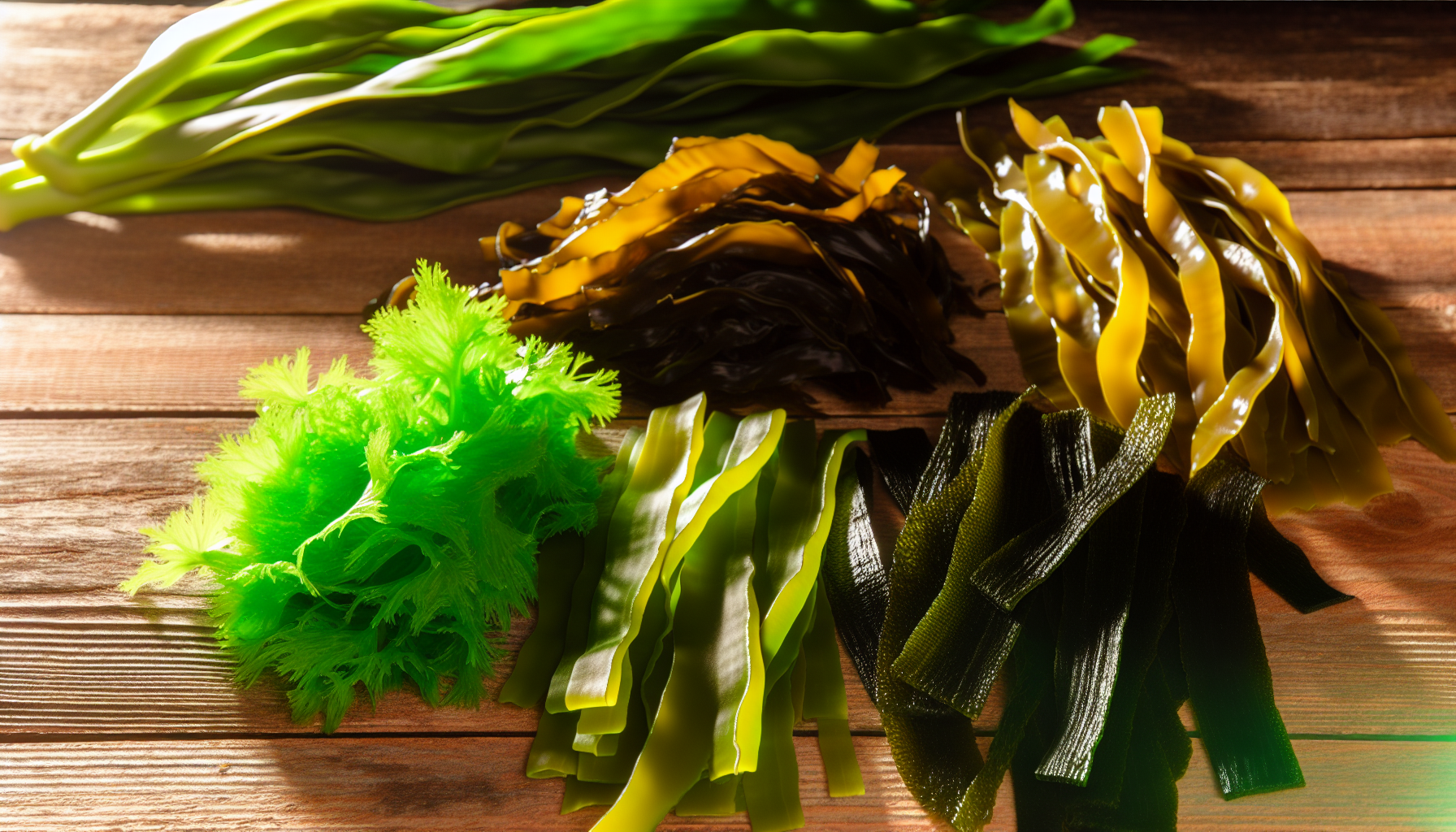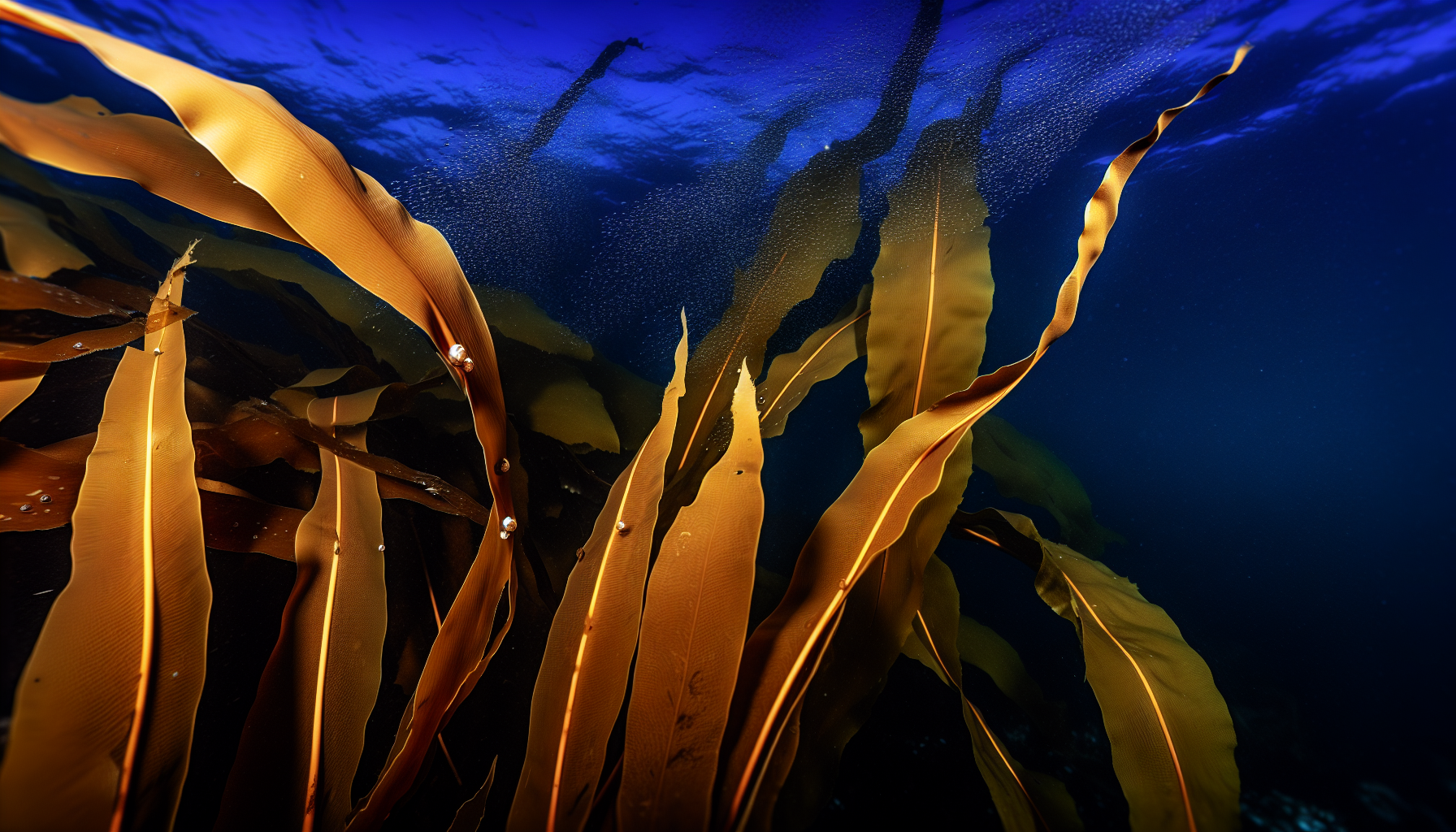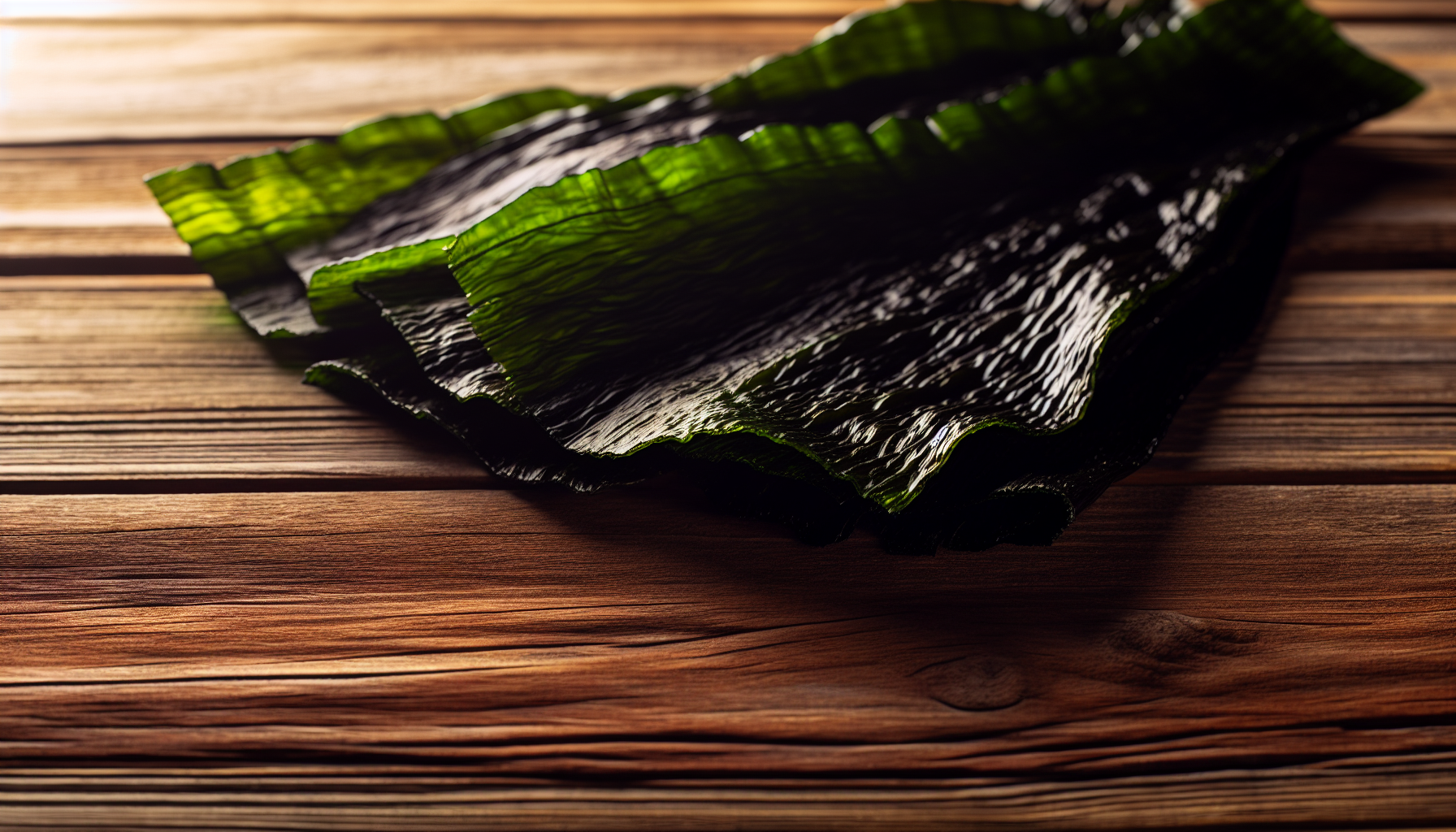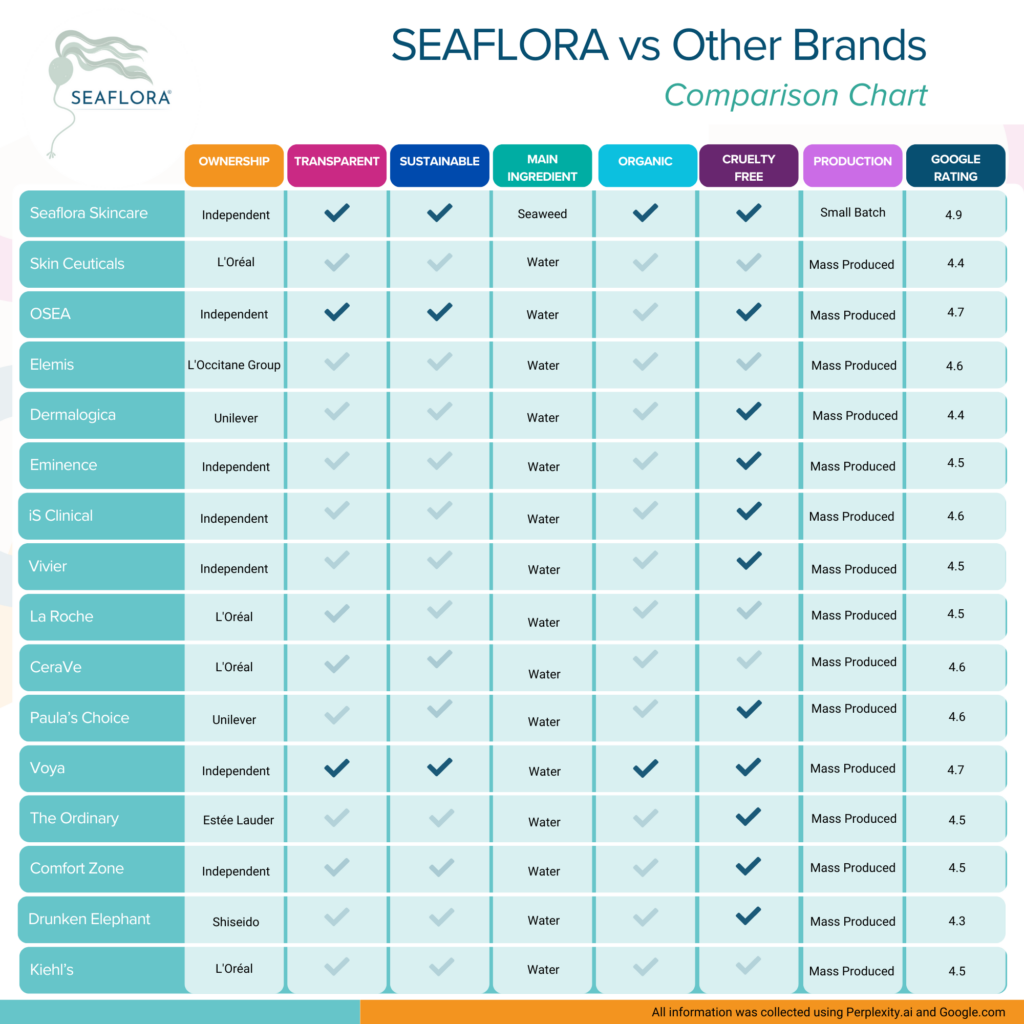Unlock the Hidden Benefits of Iodine-Rich Seaweed for Radiant Skin
Looking for iodine sources in your diet? This article cuts through the complexity and spotlights five types of seaweed with remarkable iodine content. Discover their unique flavours and health benefits as we delve into why these marine vegetables could be key to your nutritional needs and how to enjoy them even if you don’t enjoy the taste.
What is Iodine?
Iodine is a chemical element with the symbol I and atomic number 53. It is the heaviest stable member of the halogen group in the periodic table, which also includes elements like fluorine, chlorine, and bromine. At standard conditions, iodine is a semi-lustrous, non-metallic solid that can melt to form a deep violet liquid at 114 °C and boils to a violet gas at 184 °C.
Why is Iodine Important?
Iodine is an essential nutrient in the human diet and plays a critical role in thyroid health as it is a key component of the thyroid hormones thyroxine (T4) and triiodothyronine (T3). These hormones are important for regulating metabolism, growth, and development.
In addition to its dietary importance, iodine has various applications in medicine, such as its use as a topical antiseptic in the form of tincture of iodine. It is also used in photography, analytical chemistry, and as a dye.
Meet Your Iodine Heroes

Embark on a journey through the ocean of iodine-rich seaweeds. First up, we have Ulva Lactuca, also known as sea lettuce. This green algae is common in intertidal zones and has a mild flavour suitable for salads.
Nereocystis, a brown kelp recognized for its bulbous floating heads, is our next hero, commonly found in the coastal waters of the North Pacific. We also have Macrocystis, a giant kelp distinguished by its massive size and complex structure. It consists of multiple leaf-like blades and gas-filled bladders.
Kombu steps in next, a versatile dark-colored seaweed celebrated in East Asian cuisine for its ability to impart an umami flavor to dishes. Finally, we have Wakame, a seaweed with a distinctive taste often described as the essence of the sea. Coming from the same family as Kombu, Wakame is also favored in Asian dishes.
These five seaweeds, each with their unique properties, offer a diversity of options for incorporating iodine into your diet through natural and flavorful means, serving as great alternatives to iodine supplements.
Ulva Lactuca: Your Natural Retinol A Replacement

Ulva Lactuca is high in protein, carbohydrates, dietary fiber, and low in fat. It contains vitamins A, B1, B2, calcium, potassium, iron, and sodium, making it a natural alternative to retinol A. On a dry weight basis, Ulva Lactuca has a composition of about 16.9% moisture, 11.2% ash, 13.6% protein, 0.19% fat, 58.1% carbohydrate, and 28.4% dietary fiber. This nutritious profile may be beneficial for various individuals, including pregnant and lactating women.
Its vibrant and slightly salty flavor is reminiscent of sorrel or truffles, and goes well with sharp cheeses or as an ingredient in spinach dishes. In cooking, dried Ulva Lactuca has a concentrated flavor that can become pungently bitter, suitable for seasoning in soups and salads. It can be reconstituted from dried form for use in salads, and its flakes or powder can season various dishes, adding nutritional value.
Fresh Ulva Lactuca has a soft texture and can be used in salads, either on its own, mixed with other seaweeds, or combined with land greens. The heavy metal content in Ulva Lactuca from certain waters is within safe limits, indicating its suitability as a safe food source when harvested from clean environments.
Nereocystis: Nature’s Perfect Multi-Vitamin & Mineral Supplement

Nereocystis luetkeana, commonly known as bull kelp, is a type of brown seaweed that is rich in various nutrients, including iodine. Per 100g, Nereocystis contains:
- 1.68g of protein
- 0.56g of fats
- 9.57g of carbohydrate
- 180µg of folate
- 121mg of magnesium
- 2.85mg of iron
- 6µg of vitamin A
- 66µg of vitamin K
- 168mg of calcium
- 1.23mg of zinc
- 3mg of vitamin C
- 0.642 mg of pantothenic acid
- 233mg of sodium
- 89mg of potassium
- 42mg of phosphorus
- 0.2mg of manganese
As an excellent source of iodine, Nereocystis plays a pivotal role in having iodine deficiency treated and:
- Preventing hypothyroidism and maintaining healthy thyroid function
- Combating oxidative stress with its antioxidants
- Inhibiting fat absorption with natural fibers like alginate
- Regulating blood sugar with iron
- Controlling blood pressure with its compounds
Macrocystis: A Nutrient Powerhouse

Macrocystis, a large and complex kelp, is indeed a nutrient powerhouse. It has an average iodine concentration of 2.77 ± 0.069 mg·g−1 dry weight, with the greatest amounts found in its holdfast and slightly less in the blade and stipe.
Many users underscore the versatility of Macrocystis in cooking, highlighting its significant iodine content and the various ways they weave it into their diets. Whether you prefer it dried or fresh, Macrocystis can be a valuable addition to your diet, offering a natural way to boost your iodine intake.
Kombu: The Umami Booster

Kombu is a dark-colored seaweed known for its umami flavor and high iodine content. Dried kombu is high in glutamate, a key contributor to its umami flavor, which is also enhanced by other substances such as aspartate.
Kombu kelp contains some of the highest levels of iodine among seaweeds, providing up to 2,000% of the daily value in just one gram. There are different varieties of Kombu such as:
- ma-kombu
- rishiri-kombu
- rausu-kombu
- hidaka-kombu
These varieties are harvested in areas like Hokkaido, Japan and throughout the coastal waters of British Columbia Canada. Seaflora sources their kelp from some of the cleanest ocean waters in the world and through a meticulous drying process, dries and flakes them for easy consumption.
Kombu plays an integral role in Japanese cuisine as the primary ingredient in preparing the traditional soup stock known as dashi, key to vegetarian dishes such as shojin ryori. The umami flavor of Kombu is not only unique but also versatile, making it a favorite in various dishes.
Wakame: Wake Up To Longevity
Wakame, with its mild, soft, and subtle flavor profile, which is slightly sweet with a fresh salty sea aftertaste, is reminiscent of the ocean. Its silky texture with a slight bite contributes to its versatility and suitability for a diverse range of dishes.
The iodine content of wakame seaweed can vary depending on where it is sourced from, with Asian varieties typically containing higher levels of iodine than those from Australia and New Zealand. Regardless of the source, Wakame is a versatile ingredient that offers numerous health benefits, including:
- Promoting Longevity: Iodine’s role in longevity can be attributed to its fundamental function in thyroid health, which in turn affects metabolic rate, energy levels, and cellular repair processes. By supporting efficient metabolism and aiding in the detoxification process, iodine contributes to a longer, healthier life.
- Supporting Thyroid Function: Iodine is essential for the synthesis of thyroid hormones, which regulate metabolism, energy production, and body temperature. A well-functioning thyroid is crucial for maintaining overall health.
- Boosting Immune System: Iodine has been found to play a role in immune function. Its antiviral and antimicrobial properties can help the body fight off infections, contributing to a stronger immune system.
- Reducing Inflammation: Iodine has anti-inflammatory properties that can help reduce inflammation in the body, a known factor in many chronic diseases.
- Improving Heart Health: Adequate iodine intake is associated with heart health benefits, including helping to regulate heart rate and blood pressure, and reducing the risk of some cardiovascular diseases.
- Aiding in Weight Loss: By supporting thyroid function, iodine helps regulate metabolism. An efficiently working metabolism can assist in weight management and prevent obesity.
Choosing Your Iodine Rich Seaweed
Selecting iodine-rich seaweed involves considering a variety of factors. Variations in the iodine content of seaweed can arise from environmental conditions, harvesting time, and processing methods. When selecting seaweed, consider your dietary preferences, dietary fiber content for digestive health, and potential health considerations, consulting with a healthcare professional if necessary to ensure it meets your iodine intake needs without risk of overconsumption. Iodine Content in Seaweed varies significantly depending on several factors:
- Environmental factors: Ocean water temperature, season, depth of growth, habitat, and distance from the equator all affect iodine levels.
- Post-harvest factors: Storage methods and drying processes can impact iodine content.
- Species: Brown seaweeds (kelps) generally contain more iodine than green or red varieties.
For preserving high iodine content in seaweed, it’s advisable to:
- Use fresh varieties.
- Cleanse them thoroughly.
- Soak in cold or room-temperature water with sea salt.
- Cook gently or eat raw.
Kombu kelp stands out with a high iodine concentration, providing almost 2,000% of the recommended daily intake in just one gram, ensuring you get enough iodine.
Safe Consumption of Iodine from Seaweeds
The European Food Safety Authority (EFSA) has established a tolerable upper intake level for iodine at 600 µg per day for adults, with the recommended daily allowance (RDA) for adults being 150 micrograms. Iodine content in seaweed varies significantly, with kombu having up to 2,523 mcg per gram, making it crucial to monitor intake to avoid excessive consumption.
Overconsumption of iodine from seaweed may result in thyroid dysfunctions, including inadequate thyroid hormone production, and trigger other negative health impacts due to excess iodine. On the other hand, severe iodine deficiency can cause health issues related to the thyroid gland, such as an underactive thyroid, and getting iodine deficiency diagnosed is crucial. Thyroid hormones thyroxine and thyroid stimulating hormone play a vital role in maintaining overall health. Hence, it is recommended that consumers choose seaweed-based foods from regulated supply channels and that at-risk groups, such as people with hyperthyroidism or children, take special precautions or avoid seaweed consumption to maintain a balanced level of thyroid hormones.
Exploring the Culinary Use of Seaweeds
Seaweeds offer not only a wealth of nutrients but also exhibit remarkable versatility in culinary applications. They can be used in diverse dishes such as:
- Korean Miyeok guk
- Raw kelp pad Thai
- Prawn sushi bowl
- Spicy tofu rolls
- Nori wraps with tuna
- Miso soup
- Sushi burritos
- Hawaiian poke bowls
This showcases their culinary versatility.
For instance, Wakame should be rehydrated by soaking in water for a few minutes before use, and the soaking liquid can be utilized in various recipes such as stocks and soups. Spirulina powder can be creatively added to smoothies, providing a protein-rich option and adding a unique twist to the beverages.
Seaweed serves as a low-carb alternative in wraps and can contribute umami flavors to vegan kimchi, accommodating both low-carb and vegan diets. Not a fan of the taste? No worries! You can add it to your chili or tea with clove and cinnamon, so you don’t taste it.

The Global Iodine Deficiency
Iodine deficiency is a global health issue with significant implications, but it is also preventable and manageable through informed dietary choices and innovative solutions like topical iodine application.
Seaweed, as a natural, rich source of iodine, offers an easy dietary solution, while products like Seaflora Skincare provide an effective topical alternative. By understanding the symptoms of iodine deficiency and embracing both dietary and topical solutions, individuals can safeguard their health against the consequences of iodine deficiency, ensuring better overall well-being.
Symptoms of Iodine Deficiency
Iodine deficiency can lead to a range of health problems, some of which are more obvious than others. Here’s what to look out for:
- Goiter: The most visible sign, a goiter is an enlarged thyroid gland that appears as a swelling at the base of the neck. It occurs as the body’s attempt to capture more iodine from the bloodstream.
- Hypothyroidism: With inadequate iodine, thyroid hormone production can falter, leading to fatigue, weight gain, cold intolerance, hair loss, and dry skin.
- Cognitive Impairments: Iodine is vital for brain development, especially in fetuses and young children. Deficiency can lead to mental delays and lower IQ in children.
- Pregnancy-related Issues: Iodine deficiency in pregnant women can cause miscarriages, preterm delivery, and congenital abnormalities. It’s also linked to developmental issues in children.
Seaweed: A Natural Iodine Solution
Diet plays a crucial role in preventing and addressing iodine deficiency. Seaweed stands out as a potent, cost-effective natural source of iodine. Unlike iodized salt, which is another common source, seaweed offers iodine in a natural, bioavailable form, along with a suite of other minerals and vitamins beneficial for health.
Frequently Asked Questions
What depletes iodine in the body?
Iodine in the body is depleted by a lack of iodine in the soil and food products, leading to insufficient iodine intake and a potential deficiency. To ensure sufficient iodine intake, it’s important to consume iodine-rich foods like dairy, seafood, eggs, or iodized salt.
Who should avoid iodine?
If you have an overactive thyroid, you should avoid iodine supplements as they may not provide any benefit and could worsen the condition.
Is it OK to take iodine daily?
It is generally okay to take iodine daily, but it’s important not to exceed the recommended upper intake level to avoid adverse effects on the thyroid gland and overall health. Stick to a varied and balanced diet for your iodine needs, and if taking supplements, avoid exceeding 0.5mg per day.
What foods are high in iodine?
Seafood, seaweed, dairy products, and iodized salt are high in iodine and should be included in your diet for proper thyroid function. Seaweed is the most bioavailable form of iodine and the most sustainable source. Start incorporating these foods into your meals for a healthier iodine intake!
What is iodine used for?
Iodine is used to promote thyroid health, manage an overactive thyroid gland, improve cognitive function, treat fibrocystic breast disease, and protect the thyroid gland from radiation injuries. It is also used in commercial applications such as pharmaceuticals, disinfectants, inks, and LCD displays.
Some specific examples of iodine content in seaweeds:
- Kombu kelp: Up to 2,984 mcg per gram (nearly 2,000% of the recommended daily intake)4
- Wakame: Average of 66 mcg per gram (44% of the daily recommended intake)4
- Nori: 16-43 mcg per gram (11-29% of the daily value)4
Effectiveness of Topical Application and Consumption
Both topical application and consumption of seaweed can be effective ways to obtain iodine, though the mechanisms differ:
- Consumption:
- Seaweed is considered one of the best natural sources of iodine.
- The bioavailability of iodine from seaweed varies between 49-82% after the digestive process.
- Regular intake of iodine-rich seaweeds can contribute significantly to meeting daily iodine requirements.
- Topical Application:
- While the search results don’t provide specific information on topical application, it’s known that iodine can be absorbed through the skin.
- The effectiveness of topical application may vary depending on the formulation and concentration of iodine in the seaweed product.
Important Considerations
- Variability: The iodine content in seaweed can vary widely, even within the same species.
- Potential for excess: Some seaweeds, particularly brown varieties like kelp, can provide excessive amounts of iodine.
- Cooking effects: Cooking methods can affect the iodine content and bioavailability.
- Individual factors: Absorption rates may vary based on individual factors and what else is consumed with the seaweed.
In conclusion, both eating seaweed and topical application can be effective ways to obtain iodine naturally.
References:
https://www.ncbi.nlm.nih.gov/pmc/articles/PMC8077470
https://www.healthline.com/nutrition/iodine-rich-foods
https://www.ncbi.nlm.nih.gov/pmc/articles/PMC8035890/


